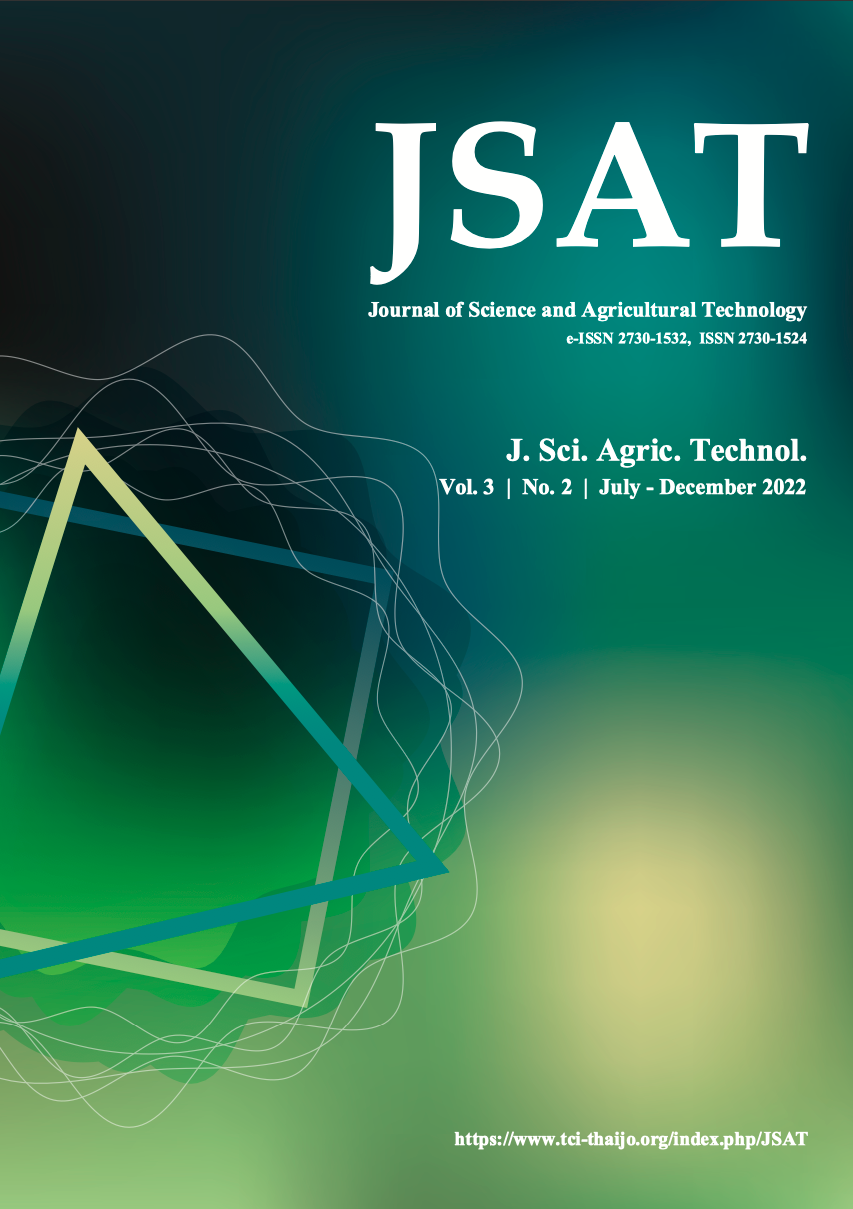Effects of electrical conductivity and micro/nanobubbles in nutrient solutions of hydroponics on growth and yield of cherry tomato
Main Article Content
Abstract
Article Details

This work is licensed under a Creative Commons Attribution-NonCommercial-NoDerivatives 4.0 International License.
References
Akrawong, F. 2011. The effect of nutrient solution concentrations on growth, yield and fruit quality of table tomato cv. ‘CLN 3125’ grown in coconut substrate. B.S. Dissertation. Kasetsart University, Bangkok, Thailand.
Ebina, K., Shi K., Hirao M., Hashimoto J., Kawato Y., Kaneshiro S., Morimoto T., Koizumi K., and Yoshikawa H. 2013. Oxygen and air nanobubble water solution promote the growth of plants, fishes and mice. PLOS ONE. 8(6): 1-7 (e65339). https://doi.org/10.1371/journal.pone.0065339.
Huett, D. O. 1993. Managing nutrient solutions in hydroponics. NSW Agriculture and Horticultural Research & Development Corporation. Wollongbar, New South Wales, Australia.
Kalra, Y.P. 1998. Handbook of reference methods for plant analysis. CRC Press, Boca Raton. Ketsakul, S. 2015. Tomato production technology. Research Project Report. Department of Agriculture, Ministry of Agriculture and Cooperatives, Bangkok. (in Thai)
Li, Y., and Stanghellini, C. 2001. Analysis of the effect of EC and potential transpiration on vegetative growth of tomato. Scientia Horticulturae. 89(1): 9–21. https://doi.org/10.1016/S0304-4238(00)00219-3.
Lu, T., Yu H., Wang T., Zhang T., Shi C. and Jiang W. 2022. Influence of the electrical conductivity of the nutrient solution in different phenological stages on the growth and yield of cherry tomato. Horticulturae. 8(378): 1-14. https://doi.org/10.3390/horticulturae8050378.
Marui, T. 2013. An introduction to micro/nano-bubbles and their applications. Systemics, Cybernetics and Informatics. 11(4): 68-73.
Maboko, M.M. Du Plooy, C. P., and Chiloane, S. 2017. Yield and mineral content of hydroponically grown mini-cucumber (Cucumis sativus L.) as Affected by reduced nutrient concentration and foliar fertilizer application. HortScience 52(12):1728–1733.
Nantakit, A. 1995. Hydroponics. King Mongkut's Institute of Technology Ladkrabang, Bangkok.
Nemali, K. S., and Van Iersel, M. W. 2004. Light intensity and fertilizer concentration: I. Estimating optimal fertilizer concentration from water-use efficiency of Wax Begonia. HortScience. 39(6): 1287-1292.
Novozamsky, I., Van Eck, R., Van Schouwenburg, J.C., and Walinga, I. 1974. Total nitrogen determination in plant material by means of the indophenol blue method. Netherlands Journal of Agricultural Science. 22: 3-5.
OAE. 2020. Agricultural statistics of Thailand 2020. Office of Agricultural Economics, Ministry of Agriculture and Cooperatives, Bangkok.
Oshita, S. and Liu, S. 2013. Nanobubble characteristics and its application to agriculture and foods. In: Proceedings of AFHW 2013, International Symposium on Agri-Foods for Health and Wealth August 5-8, 2013. Golden Tulip Sovereign Hotel, Bangkok, p. 23-32.
Park, J.S., and Kurata., K. 2009. Application of microbubbles to hydroponics solution promotes lettuce growth. Hort. Technology. 19(1): 212-215.
Park, J.S., Ohashi, K., Kurata, K., and Lee, J.W. 2010. Promotion of lettuce growth by application of microbubbles in nutrient solution using different rates of electrical conductivity and under periodic intermittent generation in a deep flow technique culture system. Europ. J. Hort. Sci. 75(5): 198-203.
Phaengkieo, D., Chaoumead, A., Wangngon, B. and Chumnumwat, S. 2019. The application of nanobubble technology for DRFT hydroponics. Journal of Innovative Technology Research. 3(2): 33-41.
Shabana, H.R., Benjamin, N.D. and Mohammed, S. 1981. Pattern of growth and development in date palm plant fruit. Date Plant Journal. 1: 31-42.
Sritontip, C., Changjeraja, C., Khaosumain, Y., Panthachod, S., Sritontip, P. and Lasak, S. 2017. Low-cost soilless cultivation (1st ed). Community Technology Transfer Center,Rajamangala University of Technology Lanna, Chiang Mai.
Stahl, W. and Sies, H. 1996. Lycopene: a biologically important carotenoid for humans. Archives of Biochemistry and Biophysics. 336(1): 1-9. https://doi.org/10.1006/
abbi.1996.0525.
Suzuki, M., Umeda, H., Matsuo, S., Kawasakia, Y., Ahn, D., Hamamoto, H., and Iwasakia, Y. 2015. Effects of relative humidity and nutrient supply on growth and nutrient uptake in greenhouse tomato production. Scientia Horticulturae 187: 44-49.
Trejo-Téllez, L.I. and Gómez-Merino, F. C. 2012. Nutrient solutions for hydroponic systems. In: Asao, T. (ed) Hydroponics–A standard methodology for plant biological researches. InTech. Croatia. p. 1-22.
Tsutsumi, H., Higashi R. and Kinugasa, T. 2020. A new technique to realize a drastic acceleration of crop growth in the DFT hydroponic cultivation with hyper-oxygenated nutrient solution. Journal of Horticulture. 7(4): 1-7.
Takahashi, M., Chiba, K. and Li, P. 2007. Free-radical generation from collapsing microbubbles in the absence of a dynamic stimulus. Physical Chemistry B. 111: 1343-1347. https://doi.org/10.1021/jp0669254.
Thepnarong, P. 2013. Effects of temperature and storage life on chilling injury of cherry tomato (Lycopersicon esculentum cv. CH154) and the application of calcium for chilling reduction. M.S. Dissertation. Suranaree University of Technology, Nakhon Ratchasima, Thailand.
Walinga, I., van der Lee, J.J., Houba, V.J.G., van Vark, W., and Novozamsky, I. 1995. Plant analysis manual. Springer, Dordrecht.
Zhou Y.P., Zhou B., Xu F., Muhammad T., and Li Y.K., 2019. Appropriate dissolved oxygen concentration and applica-tion stage of micro-nano bubble water oxygenation in greenhouse crop plantation. Agricultural Water Management. 223(36): 105713. https://doi.org/10.1016/j.agwat.2019.105713


